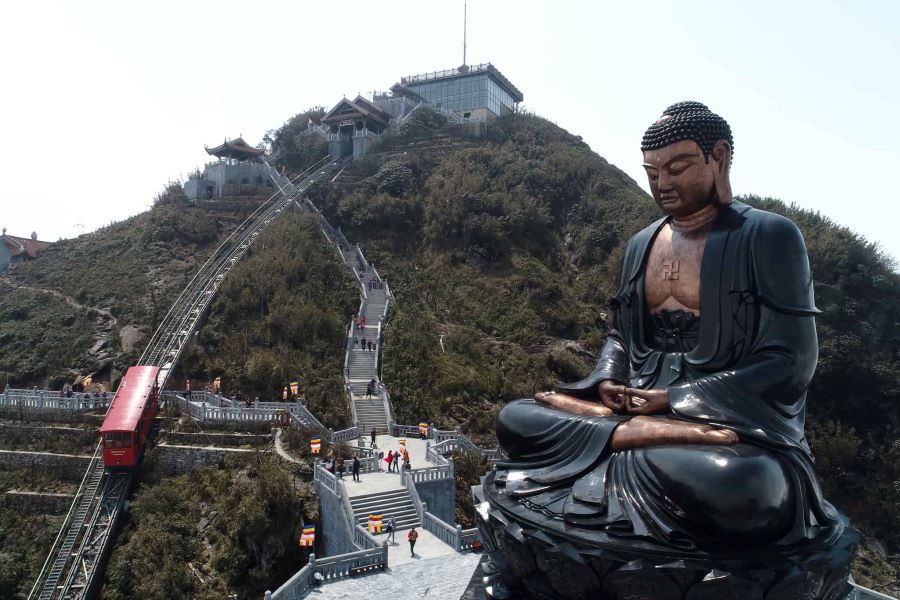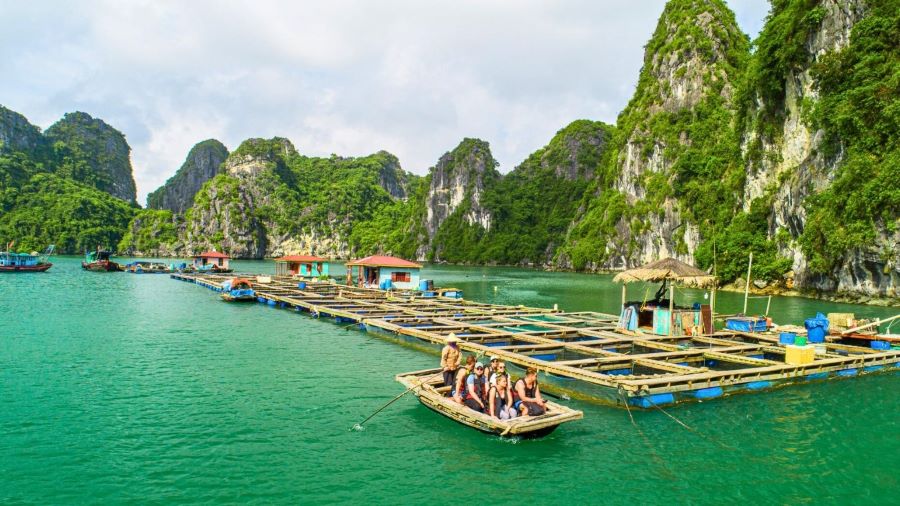Fansipan Cable Car: Fastest Way to Conquer Vietnam’s Roof
Discover the Fansipan Cable Car – one of the top Vietnam travel attractions – offering the fastest route to the peak. Learn about Fansipan cable car tickets, opening hours and station details for your journey.
A New Chapter in Vietnam Tourism
Tucked away in the misty mountains of Northern Vietnam, Sapa continues to enchant travelers with its striking rice terraces, colorful hill tribe cultures, and dramatic highland scenery. For many, reaching the summit of Fansipan-the tallest peak in Indochina-is more than just a physical conquest; it’s a journey into the heart of Vietnam’s natural and cultural wonders.
With the arrival of the cable car, what was once a grueling multi-day trek is now an easy, breathtaking 15-minute ascent through the clouds. It’s a game changer for those with limited time or physical ability, making this iconic peak more accessible than ever.
If you plan for a Northern Vietnam tour, riding the cable car is a must. In this guide, we’ll cover everything you need to know: from Fansipan cable car tickets and opening hours to station details, summit highlights, and expert travel tips to help you make the most of your visit.
Why is Fansipan the Perfect Place for a Cable Car?
Rising 3,147 meters above sea level, Fansipan-known as “The Roof of Indochina” – is not only Vietnam’s highest peak but also a cultural and spiritual icon. For generations, reaching the summit meant a challenging two to three-day trek through thick forests and rugged terrain, appealing mostly to seasoned hikers. While the traditional trail still attracts adventure seekers, the introduction of the Fansipan cable car has opened the experience to a wider range of travelers, making the peak accessible to nearly everyone.
Located just 9 kilometers from Sapa town, Fansipan lies within the Hoang Lien Son mountain range-one of the best destinations for hiking in Vietnam. The area boasts breathtaking landscapes, from mist-shrouded peaks and dramatic river valleys to iconic terraced rice fields. At the summit, visitors are rewarded with not only sweeping views that extend into neighboring countries but also a spiritual complex featuring temples and statues that reflect the mountain’s cultural significance.
Building a cable car here wasn’t just a feat of engineering-it was a thoughtful way to preserve accessibility while respecting the mountain’s natural and cultural value.
Introducing the Fansipan Cable Car Experience
The Fansipan cable car opened in 2016 and quickly became a top attraction for travelers in Vietnam and beyond. Developed by Sun Group, the system set new global standards in mountain transport. The Sun Group started constructing its Fansipan-Sapa cable car system on November 2, destined to become the world’s highest, longest and most complicated upon completion.
This impressive three-rope cable car broke several world records. It holds titles for the greatest elevation difference and the longest non-stop three-rope cable car in the world.

Experience Fansipan cable car ride-Vietnam’s gateway to sky-high adventure.
The journey begins at Hoang Lien Station. It’s located just a short ride from Sapa town and easily accessible. From there, the cable car soars above Muong Hoa Valley, one of Northern Vietnam’s most stunning landscapes. Along the way, passengers enjoy sweeping views of misty forests, rugged mountains and layered rice terraces. On clear days, the scenery feels almost surreal.
Once you reach the upper station, the summit is close but not quite there. You can hike a set of stone stairs or take a short funicular ride near the peak. This unique experience blends comfort with adventure, offering access to one of Southeast Asia’s most iconic natural wonders in under 20 minutes.
What You’ll See at the Summit?
When you step out near the summit, you enter a place filled with peace and deep spiritual significance. One of the most stunning sights is the Great Buddha Statue, rising 21.5 meters tall and wrapped in gleaming bronze. The statue gazes over the mountains, offering a quiet sense of calm and wonder.
Just a short walk away, the Kim Son Bao Thang Pagoda complex welcomes visitors with its graceful design and serene courtyards. Here, time seems to slow down. You can pause, reflect and take in the spiritual energy of the mountain.
From this lofty vantage point, the Hoang Lien Son range stretches endlessly into the horizon. Clouds often drift gently below your feet, adding a dreamlike touch to the moment. The air is fresh, the wind carries a chill and the view stirs something unforgettable. Even if you didn’t hike up, the sense of accomplishment is real and well-earned.

Above clouds, Fansipan cable car reveals the sacred Great Buddha in silence
Tickets, Prices and Logistics
• Tickets
You can purchase tickets online or at Hoang Lien Station for ease. Booking early offers cheaper fares especially before weekends and holidays Combo tickets include the funicular or other attractions like buffet meals. Always keep your round trip ticket safe because it is valid only on the day of travel.
• Prices
As of 2025, round trip cable car tickets cost 800 000 VND (about 35 USD) on weekdays and Sunday. On Saturdays and public holidays the price rises to 850 000 VND (~ 37 USD) Children between 1 m and 1.4 m pay 550 000 VND (about 25 USD). Kids under 1 m ride free. Muong Hoa Valley monorail round trip costs 200 000 VND (around 9 USD). Fansipan funicular tickets cost 150 000 VND up and 120 000 VND down.
• Logistics & Tips
The cable car operates daily typically from 7 :30 AM to 5 :30 PM. Cabins depart every 15–20 minutes based on visitor demand. Each cabin seats up to 35 passengers and welcomes wheelchairs and strollers. Visit early in the day for better visibility and shorter queues. Fog may limit summit views but the ride remains scenic and dramatic.
Local Culture and Respect
As you explore Fansipan and its surroundings, remember the deep cultural importance of this land to local communities. The region is home to ethnic minority groups such as the Hmong and Dao, whose unique traditions reflect centuries of heritage. Their lifestyles remain closely connected to the natural landscape, from farming rice terraces to crafting handmade textiles.
These communities offer a chance to experience an authentic side of Vietnam. However, respectful interaction is essential. Always ask for permission before taking photos of individuals or their homes. Uninvited photography can feel intrusive and disrespectful.

Fansipan cable car glides above villages where Hmong women live and thrive.
Whenever possible, support local guides who share knowledge passed down through generations. They provide insight into mountain life while ensuring your visit benefits their families. Buying handicrafts directly from villagers helps sustain their livelihoods and keeps cultural practices alive.
Additionally, avoid bringing plastic waste and be mindful of your environmental impact. Carry reusable bottles or bags to reduce trash in these fragile mountain ecosystems.
By making small, thoughtful choices, you help preserve both the land and its people. This approach creates meaningful connections and encourages sustainable tourism. As you journey through Muong Hoa Valley or ascend the peaks, let respect guide every step you take.
Travel Tips for the Fansipan Experience
- Best Time to Visit
For ideal weather, travel to Northern Vietnam in spring (March to May) or autumn (September to November). These seasons bring mild temperatures and clearer skies. Avoid summer rains and winter fog if you want the best summit views. - What to Pack
Dress in layers since weather changes quickly at high altitudes. A light windbreaker, water and sturdy shoes are essential. Even on sunny days, the summit can be windy and cool. Though the cable car is easy, some uphill walking is still involved. - Altitude Tips
The summit reaches over 3,000 meters. Some visitors may feel lightheaded or short of breath. Move slowly, take breaks and stay hydrated throughout your visit. - Getting There
Fansipan is easily accessed from Sapa, a town well-connected to Hanoi by sleeper bus or overnight train. The journey takes about 6-8 hours. From Sapa, it’s a 20-minute drive to Muong Hoa Valley, where the cable car station is located. - Transportation Options
Choose a taxi, shuttle or join one of the Spa tours that include transportation and tickets for a convenient experience.
Connecting Fansipan to Your Vietnam Itinerary
Visiting Fansipan can be a key highlight in a broader adventure through Northern Vietnam. Many international travelers include Sapa in a scenic loop with Hanoi, Ha Long Bay and Ninh Binh. This region offers a rich blend of natural beauty and cultural heritage. A trip to Fansipan provides a striking contrast to the energy of the capital, revealing the serene, spiritual side of the highlands.
If you’re planning an essential Northern Vietnam tour in 5 days, be sure to set aside at least one full day for Sapa. The Fansipan cable car experience is a must and pairs perfectly with visits to ethnic markets and nearby villages. A thoughtful itinerary gives you time to enjoy breathtaking mountain landscapes while also connecting with local traditions and ways of life.
Above the Clouds: A Journey Worth Taking
Fansipan is more than just the highest peak in Vietnam-it’s where nature, culture and modern design come together in harmony. For travelers looking to add something truly memorable to their Vietnam adventure, the Fansipan cable car delivers both ease and impact. It brings the majestic highlands within reach, no hiking boots required.
The ride offers not just a view but a feeling-a quiet moment above the clouds, far from the rush of daily life. It’s a rare opportunity to witness the beauty of Vietnam in our many Vietnam tours.
So bring your camera, wear something warm and let yourself rise above it all. Whether you’re chasing breathtaking views or peaceful reflection, Fansipan welcomes you with open skies and open arms.
FAQs
Start planning your tailor-made Vietnam tour by contacting one of our specialists…







